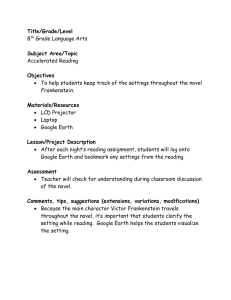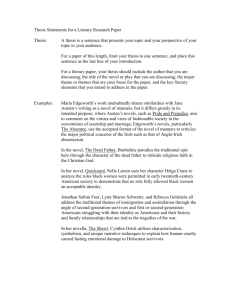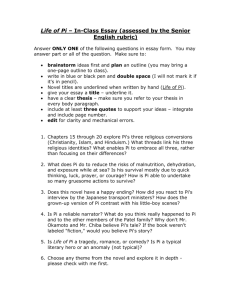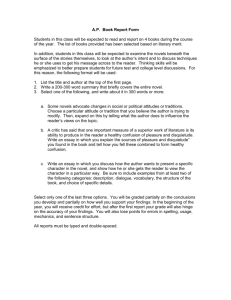Sophomore Writing Portfolio: Spotlighting your best writing
advertisement
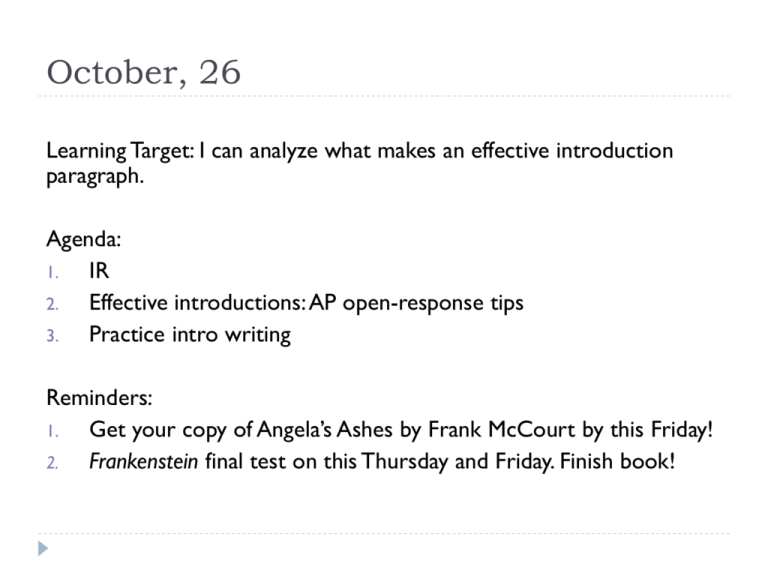
October, 26 Learning Target: I can analyze what makes an effective introduction paragraph. Agenda: 1. IR 2. Effective introductions: AP open-response tips 3. Practice intro writing Reminders: 1. Get your copy of Angela’s Ashes by Frank McCourt by this Friday! 2. Frankenstein final test on this Thursday and Friday. Finish book! Open-Ended Response Practice Writing Effective Introductions Building your introduction 1. Universal statements 2. More specific statements that name title of work, author, and genre Or PULL FROM PROMPT 3.Thesis statement that lists 3 major points to be covered in essay Let’s practice universal statement… Topic of paper 1. School dress code 2. Setting in a novel 3. Banning e-cigarettes 4. How tone and mood drives the character development of a novel. 5. Should schools allow teachers to carry weapons? Universal statement Not Included in an Introductory Paragraph No explanation of arguments! The introduction is not a place to provide detailed explanations of your supporting details because these explanations will occur in your body paragraphs. Do not tell your audience what you are going to do. “I am going to tell you this…” Consider This Introduction In my essay, I am going to tell you about the importance of an introductory paragraph. My first reason introductory paragraphs are important is because they include important information to guide the audience, such as main ideas and thesis. My second body paragraph will tell you about how the introduction functions as the outline for the reader to know where the writer is going with their ideas. Third, my final point is that introduction paragraphs engage the audience by including a hook because without the hook the readers will not be interested in the writing. These are the reasons why the introduction is important to have. Clear Thesis? Interesting lead? Outline of main ideas? Consider This Introduction According to many writing experts, the introductory paragraph is considered to be the most difficult component of an essay to compose. Introductory paragraphs include vital information to guide the reader. Additionally, the introduction works as an outline of the writer’s argument. Another important role of the introductory paragraph is to include an engaging hook to entice the audience to continue reading the composition. Therefore, writers should craft strong, detailed introduction paragraphs because this paragraph is the seed from which their writing will grow. Sample Introduction Throughout literature, reoccurring symbols and motifs emerge to guide readers to a deeper, more complete understanding of a text. In Ralph Ellison’s seminal work, Invisible Man, there are countless symbols that add complex nuances to the novel. These symbols allow the reader to fully understand the plight of the narrator by adding subtext and meaning to seemingly normal events. One symbol that is pervasively used throughout the novel is the depiction of color which sheds light on the novel’s depiction of racism, isolation and lack of opportunity. Sample Introduction Throughout literature, reoccurring symbols and motifs emerge to guide readers to a deeper, more complete understanding of a text. In Ralph Ellison’s seminal work, Invisible Man, there are countless symbols that add complex nuances to the novel. These symbols allow the reader to fully understand the plight of the narrator by adding subtext and meaning to seemingly normal events. One symbol that is pervasively used throughout the novel is the depiction of color, which sheds light on the novel’s depiction of racism, isolation and lack of opportunity. Thesis Open-ended question practice #1 Choose a literary device about a novel of literary merit. Discuss how the literary device reveals details and specifics that reveal something about the plot, character and/or setting of a novel 1. So….what is this prompt asking me to argue? 2. What’s my thesis statement going to be? My 3 claims? 3. Start with a universal statement that relates to the topic. 4. Next give specifics about literary piece. Pull from prompt. 5. Thesis statement….BOOM! Get some feedback . . . Read your introduction aloud to your group. Get feedback on the following: Did the introduction move from universal to more specific to specific? (Writer might use elements from the prompt.) Did the writer include the title, author and genre in the middle of the introduction? (This is where the writer transitions from universal to a focus on the selected piece of literature.) Did the writer “pull from the prompt” to establish context.? Did the thesis statement include the main points to be covered in the essay? (This is where you check to make sure all parts of the prompt are addressed.) Tuesday, October 27 Learning Target: I can correctly cite evidence from text using MLA citations. Agenda: 1. IR/reading check 2. Citing evidence What are Parenthetical Citations? Acknowledging words, facts, or ideas from another source. Why do we need parenthetical citations? It is important to give credit to the sources you use. When you copy words and ideas that are not yours and use them without giving credit, it is called plagiarism. How do I avoid plagiarism? You can avoid plagiarism, which is a serious offense, by giving credit to your sources. People who plagiarize may receive a failing grade or even be expelled from school. Doesn’t the “Works Cited” page give credit? Yes, the Works Cited page at the end of your paper is important in giving credit to the sources you used. However, it doesn’t give your reader information on what exactly you used from each source or exactly where you found the material. When must you give credit? 1. When you quote exact words If you use the exact words of an author, you need to include them in “quotation marks.” Give Credit When you summarize facts and ideas from a source: Summarizing means taking ideas from a larger passage and condensing them into your own words. Give Credit When you paraphrase: If you use the ideas or opinions from someone else and restate them in your own words, you still need to cite the source. When do you not have to cite a reference? If the information is well known If the information can be found in dictionaries Statistics and information that can be easily found in several sources and are not likely to vary from source to source Citing sources when you have all the information The most common type of credit (citation) lists the author’s last name and the page number in parentheses. In 1900, the worst hurricane in the United States history hit Galveston, Texas. “A storm surge almost two stories high broke over the city, causing 20- foot (6.1 meter) floods and more than 8,000 deaths” (Skelton 4). • If you already name the author in your report, just include the page number in parentheses. In Hurricane Force, Michael Miles explains that cool air draws heat and moisture from warm bodies of water to form a storm (22). Citing sources when some of the information is missing Some sources do not list an author. In those cases, use the title and page number. The winds of a hurricane are most violent around the eye (“Hurricane Season” 7). Some sources do not use page numbers. In those cases, list just the author. Hurricanes in the Indian Ocean are called cyclones (Nealy). If a source does not list the author or page number, use the title. In Southeast Asia, they are called typhoons (“Big Wind”). Citing sources when some of the information is missing Some sources do not list an author. In those cases, use the title and page number. The winds of a hurricane are most violent around the eye (“Hurricane Season” 7). Some sources do not use page numbers. In those cases, list just the author. Hurricanes in the Indian Ocean are called cyclones (Nealy). If a source does not list the author or page number, use the title. In Southeast Asia, they are called typhoons (“Big Wind”). Always check to make sure you give credit to your sources Include a Works Cited page: A complete list of every source that you make reference to in your report. This provides the information necessary for a reader to locate and retrieve any sources cited in your paper. Use parenthetical citations when you Quote Summarize Paraphrase Wrap up a great paper ! Wednesday, October 28 Learning Target: I can write an effective conclusion Reminders: Finish Frankenstein tonight! Test is tomorrow (written portion) and Friday (m/c portion) Get your copy of Angela’s Ashes What makes an effective conclusion? Memorable: Leaves the reader with something to think about. Logical: the reader is forced to agree because it made so much sense The “So…What?” has been answered! Go back to your thesis statement, and make sure you’ve demonstrated it. Do NOT summarize! 4-step conclusion: 1. Start with a statement that tells the reader what is obviously apparent about the topic. “At face value…” “On a superficial glace…” “It is obvious/apparent...” Example: When reading Frankenstein, it is obvious to the reader that the theme of the power of knowledge plays a major role in the development of the novel. 4-step Conclusion 2. Next tell the reader what can be seen by looking more deeply into situation. “However, upon more careful examination, it is clear to the reader…” “Yet, when looking more deeply into __________, it is apparent that…” “When taking a closer look at ____________, the reader can see that…” Example: However, upon more careful examination, it is clear to the reader that this theme has both positive and negative consequences throughout the plot of the novel. 4. Step Conclusion 3. Next, transition to your thesis and restate it using brand new words. Example: Through a careful look at the novel, it is apparent that Shelley portrays that knowledge has both awesome, yet simultaneously destructive power. 4-step Conclusion Now bring it home: Go deep here. Relate the topic to the world at large, current issues that people face today, end call to action etc. Example: This duel power of knowledge is not only thematically prevalent in Frankenstein, but in the world of medical ethics today. 4-step Conclusion When reading Frankenstein, it is obvious to the reader that the theme of the power of knowledge plays a major role in the development of the novel. However, upon more careful examination, it is clear to the reader that this theme has both positive and negative consequences throughout the plot of the novel. Through a careful look at the novel, it is apparent that Shelley portrays that knowledge has both awesome, yet simultaneously destructive power. This duel power of knowledge is not only thematically prevalent in Frankenstein, but in the world of medical ethics today. Now you try it… Take the prompt that you wrote an intro before on Monday and construct a strong conclusion using the 4step process. Choose a literary device about a novel of literary merit. Discuss how the literary device reveals details and specifics that reveal something about the plot, character and/or setting of a novel October 29, 2015 Learning Target: I can write an effective on-demand essay. Reminders: Have you gotten your copy of Angela’s Ashes, by Frank McCourt???? Donate your copy of Frankenstein next Wednesday, get extra credit on the test!!!

